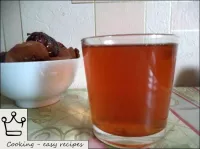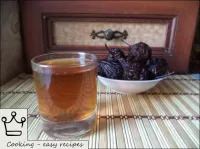Compotes
Compote is a drink made from berries and fruits, obtained during their cooking or pouring with boiling water with subsequent sterilization. "Compot" comes from Latin. "compositus," which means the indiscriminate mixing of heterogeneous objects and phenomena. More details about the compote...For the first time, the term "compote" began to be used in France. However, the recipe for compote was known in Russia long before this term came into our use. How to cook compote our brews have known for a long time. In Russia, compotes were called vats. In Ukrainian, dried fruit compote is called uzvar. The name derived from the verb "brew. " It is in brewing that the traditional recipe for dried fruit compote lies. The fact is that such compote is not boiled, but only brought to a weak boil - "cooked. " Now you will not be lost in guess how much to cook compote from dry fruit. If you follow this old recipe, the benefits of dried fruit compote are greatest, because vitamins and other useful substances are preserved in the drink almost completely. Such a compote of dried fruits must be given to infuse. So they make compote from dried apples, compote from dried apricots, compote from prunes, compote from raisins. Compotes from a mixture of dried fruits, for example, prunes and dried apricots compote, are useful and tasty. The recipe for dried fruit compote is very useful for those who want to lose weight, because the calorie content of dried fruit compote is small and amounts to about 60 Kcal per 100 g of drink. A similar cooking technology has a compote of frozen berries: frozen berries laid out in glasses are simply poured with hot syrup.
Compotes are harvested a little differently for the winter. To do this, they are boiled, and then sterilized, rolled into jars - preserved. This technology was invented at the beginning of the 19th century by the French chef Nicolas Upper, who won the competition for the supply of the Napoleonic army. It is thanks to him that today we know not only how to cook compote, but also how to save it in winter. Compotes for the winter are one of the most common types of blends. Ah, how nice it is to open some fragrant berry compote in winter: rose hips compote, strawberry compote, cranberry compote, cherry compote, blackcurrant compote. Orange compote, tangerine compote and lemon compote have an original taste. Compote can also be made from some vegetables, for example, rhubarb compote.
Compote is most often prepared on sugar syrup. It should be remembered that for each type of fruit and berries you need a syrup of different strength. For example, blackcurrant compote, redcurrant compote, cherry compote and strawberry compote are prepared with 60% syrup; pear compote, cherry compote, apple compote, grape compote - 30%.
Compotes are made from a variety of fruits and berries: cherry compote, cherry compote, blackcurrant compote, red currant compote, apricot compote, peach compote, plum compote, gooseberry compote, raspberry compote, cherry plum compote, dogwood compote. . . But the most common, perhaps, is apple compote. At the same time, not every hostess knows how to cook apple compote. The most delicious compote of fresh apples is obtained from sour-sweet varieties of apples. For apple compote, it is better to choose strong, ripe, but not overripe and not green fruits. Soft apples will quickly fall apart, and green apples do not yet have enough taste and aroma. No less popular pear compote is prepared according to the same principle as apple compote, but it takes longer to sterilize pear compote, because pears contain less acid than apples.
 Español
Español Français
Français Português
Português Русский
Русский 简体中文
简体中文 繁體中文
繁體中文 日本語
日本語 한국어
한국어 العربية
العربية Türkçe
Türkçe Қазақ
Қазақ Deutsch
Deutsch Italiano
Italiano Українська
Українська



